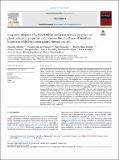Por favor, use este identificador para citar o enlazar a este item:
http://hdl.handle.net/10261/337755COMPARTIR / EXPORTAR:
 SHARE SHARE
 CORE
BASE CORE
BASE
|
|
| Visualizar otros formatos: MARC | Dublin Core | RDF | ORE | MODS | METS | DIDL | DATACITE | |

| Título: | Long-term adoption of reduced tillage and green manure improves soil physicochemical properties and increases the abundance of beneficial bacteria in a Mediterranean rainfed almond orchard |
Autor: | Özbolat, Onurcan; Sánchez-Navarro, Virginia; Zornoza, Raúl; Egea-Cortines, Marcos; Cuartero Moñino, Jessica; Ros Muñoz, Margarita Matilde; Pascual, J. A. CSIC ORCID; Boix-Fayos, Carolina CSIC ORCID; Almagro, María CSIC ORCID; de Vente, Joris CSIC ORCID; Díaz-Pereira, Elvira; Martínez-Mena García, M. Dolores CSIC ORCID | Palabras clave: | Bacteria Crop diversification Sustainable management Tillage Green manure |
Fecha de publicación: | 1-ene-2023 | Editor: | Elsevier BV | Citación: | Geoderma 429: 116218 (2023) | Resumen: | Soil health and function is one of the most important components for sustainable management of woody orchards. Intensive use of machinery and tillage creates heavy pressure on agroecosystems by altering the soil physicochemical and biological characteristics. In this study we aimed to assess the changes in soil physicochemical properties and the soil bacterial community structure, as well as the main drivers involved in shifts in the microbial community following 10 years implementing reduced tillage and reduced tillage plus green manure in a rainfed Mediterranean almond orchard. The treatments were: i) conventional tillage (CT); ii) reduced tillage (RT); and iii) reduced tillage and diversification with Avena sativa and Vicia sativa (RTD). After ten years, the results showed that the different managements had no significant effect on almond yields. RTD significantly increased total organic carbon (TOC), with an average content of 19.5 g kg−1 compared to 17.1 g kg−1 in CT. RTD also contributed to an increase in the fraction of soil macro-aggregates. Both RT and RTD significantly increased soil total nitrogen (NT) and particulate organic carbon (POC). However, other physical and chemical variables such as exchangeable Ca, Mg and K, bioavailable Fe, Cu, Zn and Mn, cation exchange capacity, bulk density, wilting point and field capacity were not significantly affected by the management. The bacterial community significantly changed with management: RTD showed a higher relative abundance of the family Solirubrobacteraceae and the genera Streptomyces and Solirubrobacter. The bacterial community structure was explained by changes in TOC, POC, pH, and NT values. Thus, a combination of reduced tillage and green manure could represent an appropriate sustainable management for rainfed almond orchards in very fragile environmental conditions, due to an increase in soil organic matter, total nitrogen, and the higher presence of beneficial bacteria related to soil productivity | Versión del editor: | https://doi.org/10.1016/j.geoderma.2022.116218 | URI: | http://hdl.handle.net/10261/337755 | DOI: | 10.1016/j.geoderma.2022.116218 | ISSN: | 0016-7061 |
| Aparece en las colecciones: | (CEBAS) Artículos |
Ficheros en este ítem:
| Fichero | Descripción | Tamaño | Formato | |
|---|---|---|---|---|
| Onurcan2023abono.pdf | articulo principal | 1,36 MB | Adobe PDF |  Visualizar/Abrir |
| Onurcan2023abono_sup.docx | Material suplementario | 241,63 kB | Microsoft Word XML | Visualizar/Abrir |
CORE Recommender
SCOPUSTM
Citations
14
checked on 29-mar-2024
WEB OF SCIENCETM
Citations
13
checked on 14-feb-2024
Page view(s)
33
checked on 27-abr-2024
Download(s)
28
checked on 27-abr-2024
Google ScholarTM
Check
Altmetric
Altmetric
Este item está licenciado bajo una Licencia Creative Commons

